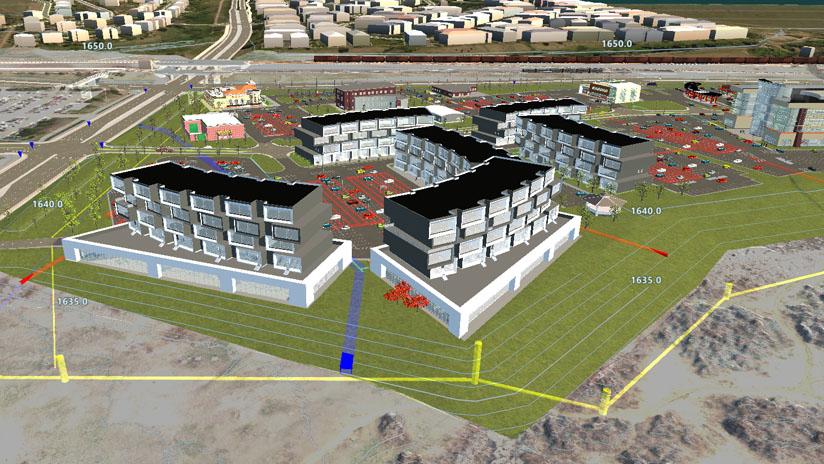Summary
The magnitude of buildings and infrastructure management needed to meet world demand by 2050 is unprecedented. The architecture, engineering, and construction (AEC) industry is up to that task, but it will take a concerted effort including implementing more efficient workflows. The integration of building information modeling (BIM) and geographic information system (GIS) processes and technologies can contribute significantly to help AEC firms meet those challenges. For many years, the potential benefits of that integration have been discussed, and the promise has finally arrived. It’s time to make it real!
Growth demands
The rate of change to the natural and built environments is increasing rapidly. Mass urbanization, population growth, and associated human habitation requirements, transportation, and climate change mitigation are driving those changes. Over the next 30 years, meeting growth demands will require constructing an estimated 13,000 buildings per day and more than 150,000 miles of urban roads and 500,000 miles of rural roads per year¹. That is an incredibly challenging goal!
Achieving the goal
Can the world achieve that goal while providing a sustainable, high quality of life for people and protecting the environment? Yes—but it will take a continuous effort plus more efficient and effective coordination, communication, and cooperation among AEC companies; investors/developers; national, state, and local governments; and public stakeholders.
Role of technology
Technology can contribute to achieving that goal in many ways, such as streamlining work processes, sharing information, and visualizing proposed building and infrastructure developments. BIM and GIS are two key processes and tools that support all phases of the AEC project life cycle (plan, design, build, and operate).
BIM and GIS
At a high level, BIM provides detailed information about buildings and infrastructure assets. The BIM process creates an integrated database(s) of an asset that includes a 3D digital representation of its physical and functional characteristics and extensive alphanumeric data about associated components/objects. It is a shared information resource that supports document management, coordination, collaboration, and simulation. BIM provides a reliable foundation for project teams to make decisions throughout the project life cycle.
GIS provides information about those assets in the context of the natural and built environments and other vital factors, such as demographic, socioeconomic, and environmental considerations. It is a framework for gathering, integrating, managing, analyzing, and visualizing geospatial data using maps and 3D scenes. With this unique capability, GIS reveals deeper insights into data, such as patterns and spatial relationships. Ultimately, this helps users make better-informed decisions about the operation and maintenance of those assets.

Drivers for integration
Both BIM and GIS play unique and valuable roles in supporting the life cycle of building and infrastructure projects. However, there is a significant need to effectively integrate those tools at the workflow level, so project participants and stakeholders can capitalize on their capabilities and benefits.
Digital transformation through the adoption of technological advances is a driving force in the AEC industry. Integrating BIM and GIS supports that transformation, and it demonstrates an AEC firm’s commitment to process improvements and technical excellence. Reducing internal silos between disciplines, streamlining workflows, and increasing productivity are differentiators in the marketplace that help AEC organizations be more competitive in the bid process. In addition, it increases their ability to collaborate with internal and external stakeholders.
Another driver is the growing number of countries, states, cities, and other government entities that are mandating various levels of BIM standards for delivering project information for permitting and other business processes. Many governments are now implementing those standards for centrally procured projects. A growing number of those entities also require BIM data to be integrated into their GIS-based systems of record, such as adding 3D models of new buildings to their citywide 3D urban planning database.
Recently, there have been significant advances in BIM and GIS integration technologies, especially between Esri and Autodesk software offerings (e.g., ArcGIS Pro, InfraWorks, Civil 3D, and Revit). In addition, advancements in storage, compute power, and the distribution of data on the internet enable BIM and GIS integration to bring tremendous value to project delivery, management, and operations for buildings, infrastructure, and the surrounding managed environment.
Integration benefits
BIM and GIS not only help design and construction teams work more efficiently, but they also enable the data created during those processes to be used for a wide range of operations and maintenance activities, such as facilities management, space planning, and security.
There are numerous benefits from integrating BIM and GIS, including the following:
- Capitalize on existing investments in BIM and GIS software to increase return on investment (ROI).
- Advance the understanding of projects in the context of their location; what’s built; and broader environmental, demographic, economic, and other factors.
- Enable collaborative workflows that minimize data loss and reduce inefficiencies.
- Make better-informed decisions to accelerate project delivery and improve the operations and maintenance of completed assets.
- Help architects, engineers, and GIS teams work together more effectively to put data at the center, remove silos, and connect workflows.
- Enable architects and engineers to design smarter, more efficient buildings and infrastructure; help understand the impacts of these structures on the environment; collect and analyze data from the field; and improve communication with key stakeholders.
- Connect existing systems of record to create a federated source of truth that helps minimize costly errors and delays regarding critical design decisions.
Let’s get started
The demand is clear, the drivers are understood, and the benefits are apparent. But how do you get started? How do you make it real? Esri offers many resources to help customers achieve the benefits of integrating BIM and GIS including workshop engagements, blogs and videos, and a Esri Community.
BIM and GIS Integration Workshop
The workshop is a two-day engagement that focuses on informing customers about common patterns, tools, and workflows for integrating BIM and GIS capabilities and using them to support AEC project work. The format is a combination of presentations, demonstrations, and hands-on learning using Esri and Autodesk software and standard datasets. It can be conducted remotely or on-site at a customer’s facility.
Day 1: Introduction to BIM and GIS Integration provides an overview of the business, integration patterns, and technologies. Day 2: Hands-On Integration Techniques allows participants to use the software and integration workflows discussed on Day 1.
The workshop is designed for several audiences including the following:
- Practice leads and project managers responsible for the successful delivery of AEC projects and services.
- Architects, engineers, landscape architects, other designers, and GIS professionals who use BIM and GIS technologies to support AEC projects.
For more information about the workshop, contact us at AEC_Consulting@esri.com.
Blogs and Videos
- Common Patterns for BIM and GIS Integration by Chris Andrews
- 5 Myths and 5 Realities of BIM-GIS Integration by Chris Andrews
- How to Georeference Revit Data in ArcGIS Pro by Don Kuehne
- BIM-GIS Integration with IFC by Don Kuehne
Esri Community
Esri Community is where customers, partners, Esri staff, and others in the GIS and geospatial professional community—connect, collaborate, and share experiences.
Esri Community offers a dedicated AEC community. We invite you to join the conversation!
Conclusion
The high rate of world growth and change is driving the need for private and government organizations to streamline business processes to increase efficiency and effectiveness. More holistic and integrated workflows in the AEC life cycle are being implemented to reduce costs, meet growth demands, and comply with government mandates. The demand will only increase over time. The integration of BIM and GIS technologies is a valuable component of the overall solution to meet the tremendous building and infrastructure development needs over the next 30 years and beyond. The exciting part is that although significant progress has been made, we are only just beginning to scratch the surface when it comes to realizing the benefits of those technologies. I can’t wait to see what the future holds.
Reference
¹ https://damassets.autodesk.net/content/dam/autodesk/www/solutions/architecture-engineering-construction/docs/20190322_Autodesk_Whitepaper.pdf

